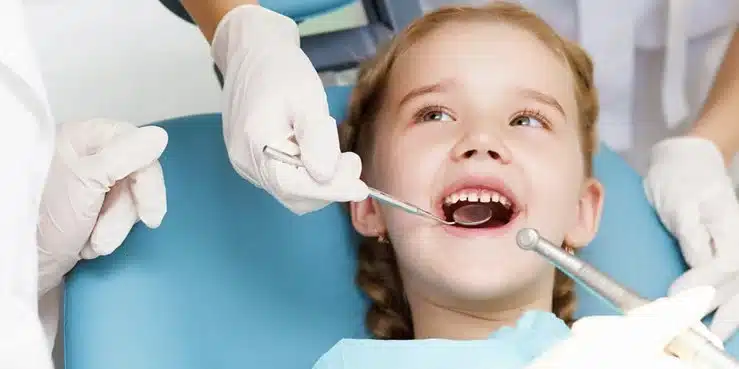When parents first hear their child might benefit from early orthodontic treatment, a wave of questions often follows. It’s natural to feel protective of your child’s developing teeth—after all, no parent wants to make a choice that could cause long-term harm. Among the most pressing concerns is a fundamental fear: “Will early orthodontics cause weak tooth roots?” This worry is understandable, especially when considering treatment for children whose permanent teeth are still developing.
Early orthodontic treatment, also known as Phase I treatment, typically begins between the ages of 6 and 9 when children still have a mix of baby and permanent teeth. The goal isn’t to achieve a perfect smile immediately but to guide proper jaw growth and create space for emerging permanent teeth. Despite its proven benefits, many parents hesitate due to misconceptions about potential risks to their child’s developing roots.
This article aims to separate fact from fiction, examining the real science behind early orthodontic care and its impact on tooth root health. We’ll explore current research, modern treatment approaches, and address the most common myths that prevent children from receiving timely orthodontic intervention when needed.
Setting the Record Straight: What Parents Need to Know First
Before diving into specific myths, it’s crucial to understand that modern orthodontics has evolved significantly from the practices of previous generations. Today’s orthodontists use gentler forces, advanced imaging technology, and evidence-based approaches specifically designed for growing children. The tools and techniques used in early treatment are fundamentally different from those used in adult orthodontics, taking into account the unique characteristics of developing teeth and roots.
Root health is always a primary concern for orthodontists, especially when treating young patients. Every treatment plan is carefully crafted to work with, not against, natural growth patterns. Understanding this foundation helps parents approach early orthodontic discussions with confidence rather than fear.
Myth #1: Early Orthodontics Damages Tooth Roots
The belief that early orthodontic treatment inherently damages tooth roots stems from outdated information and misunderstandings about how modern orthodontics works. This myth often originates from stories of aggressive treatment methods used decades ago or confusion about a condition called root resorption.
Root resorption is a process where the body naturally breaks down and absorbs root tissue. While it can occur during orthodontic treatment, it’s typically minor and doesn’t affect tooth stability. Modern orthodontists are trained to identify patients at risk and adjust treatment accordingly.
They use controlled, gentle forces specifically calibrated for young patients, dramatically reducing any risk of significant root damage. Research consistently shows that when early orthodontic treatment is properly planned and executed, the incidence of problematic root resorption is extremely low.
Orthodontists regularly monitor root health through X-rays and adjust treatment if any concerns arise. The key is working with qualified professionals who understand pediatric dental development and use appropriate force levels for growing teeth.
Myth #2: Children’s Teeth Are Too Fragile for Braces
Many parents worry that their child’s developing teeth can’t handle the pressure of orthodontic appliances. This misconception overlooks the remarkable adaptability of young dental structures. Children’s teeth and supporting bone are actually more responsive to orthodontic forces than adult teeth, allowing for more efficient and effective treatment.
The concern about fragility often confuses the natural looseness of baby teeth ready to fall out with the stability of permanent teeth and their roots. Orthodontists carefully distinguish between these stages and only apply forces to teeth that can safely handle them. Treatment plans for young patients use significantly lighter forces than those used for adults, respecting the developing root structures while still achieving desired movement.
Furthermore, early orthodontic treatment isn’t limited to traditional braces. Many interventions use gentle appliances like palatal expanders or space maintainers that work with natural growth patterns rather than forcing dramatic tooth movements. These tools guide development rather than aggressively repositioning teeth.
What the Research Really Says
Scientific evidence provides reassuring answers to the question “Will early orthodontics cause weak tooth roots?” The American Association of Orthodontists, based on extensive research, supports early evaluation and, when necessary, early intervention.
Studies comparing children who received early treatment with those who waited show no significant difference in root health outcomes. A landmark study published in the American Journal of Orthodontics and Dentofacial Orthopedics followed children through both early and comprehensive treatment phases.
Researchers found that root resorption, when it occurred, was typically minimal and didn’t compromise tooth longevity. The study emphasized that treatment timing was less important than treatment quality and proper monitoring.
More recent research utilizing 3D imaging technology has provided even more detailed insights into root behavior during orthodontic treatment. These studies confirm that young roots are remarkably resilient and that early intervention, when indicated, doesn’t increase the risk of root problems compared to delayed treatment.
In fact, addressing certain issues early can prevent more aggressive interventions later that might pose greater risks to root health.
The Role of Digital Monitoring in Protecting Root Health
Modern orthodontics has embraced digital technology, revolutionizing how practitioners monitor and protect root health during treatment. Gone are the days of relying solely on traditional film X-rays with limited visibility. Today’s digital imaging provides unprecedented clarity and detail of root structures throughout treatment.
Three-dimensional cone beam computed tomography (CBCT) allows orthodontists to view roots from every angle, detecting even subtle changes that might indicate a need for treatment adjustment. These advanced imaging tools use significantly less radiation than older methods while providing far more information. Regular digital monitoring enables orthodontists to track root length, shape, and density with precision previously impossible.
This technological advancement directly addresses concerns about root damage by allowing real-time adjustments to treatment plans. If any signs of unusual root resorption appear, orthodontists can immediately modify forces, change appliances, or temporarily pause treatment. This level of control and monitoring makes early orthodontic treatment safer than ever before.
Why Early Treatment Is Sometimes Necessary
Understanding when early orthodontic intervention is truly necessary helps parents make informed decisions rather than avoiding treatment due to unfounded fears. Certain conditions, if left untreated, can lead to more serious problems requiring more invasive corrections later.
Crossbites, where upper teeth sit inside lower teeth, can cause uneven jaw growth and tooth wear if not corrected early. Severe crowding might lead to impacted teeth that never properly emerge. Excessive protrusion of front teeth increases injury risk and can affect a child’s self-esteem. These issues often worsen with time, potentially requiring tooth extraction or jaw surgery if treatment is delayed.
Early treatment aims to guide growth and development, not to achieve perfect alignment of all teeth. By addressing skeletal discrepancies and creating proper space for permanent teeth, orthodontists can often prevent more complex problems. This interceptive approach works with natural growth patterns, requiring less force and posing minimal risk to developing roots.
Comparing Early vs. Late Orthodontics
Phase I treatment, typically lasting 12-18 months, focuses on skeletal issues and creating space for proper tooth eruption. It’s followed by a retention period where the child’s remaining permanent teeth emerge naturally. Phase II treatment, if needed, fine-tunes tooth alignment once all permanent teeth are present. This two-phase approach often requires less aggressive movement in each phase compared to attempting everything at once later.
Contrary to popular belief, early treatment doesn’t mean children wear braces longer overall. The treatment is strategically spaced to work with growth spurts and tooth eruption patterns. Studies show that addressing certain problems early can actually reduce the complexity and duration of later treatment, potentially minimizing any risks to root health.
Myth #3: Early Braces Mean a Longer Total Treatment Time
Parents often worry that starting orthodontic treatment early condemns their child to years of continuous braces. This myth misunderstands how phased treatment works. Early intervention isn’t about keeping braces on longer; it’s about timing treatment to coincide with natural growth periods.
After Phase I treatment, most children enjoy a break of several years while their remaining permanent teeth emerge. During this time, they might wear a simple retainer but aren’t in active treatment. When Phase II begins, it’s often shorter and less complex because major skeletal issues were already addressed. The total time in active treatment across both phases is frequently comparable to or even less than comprehensive treatment started later.
Myth #4: Any Orthodontist Can Monitor Root Health the Same Way
Not all orthodontic care is created equal, particularly when it comes to monitoring root health in growing children. While general dentists may offer orthodontic services, board-certified orthodontists undergo additional years of specialized training focused specifically on tooth movement and facial development.
Orthodontists possess unique expertise in recognizing subtle signs of root stress and understanding growth patterns that affect treatment outcomes. Their advanced training prepares them to make critical decisions about treatment timing, force application, and when to modify approaches based on individual patient response.
Choosing a qualified orthodontist becomes even more critical for early treatment. Parents concerned about root health should seek providers with specific experience in pediatric orthodontics and a track record of successful early interventions.
Red Flags to Watch for in Early Treatment
While serious complications are rare with properly managed early orthodontic treatment, parents should know what warning signs merit immediate attention. Excessive pain beyond normal adjustment discomfort, teeth becoming notably loose, or visible changes in gum health all warrant prompt consultation with the orthodontist.
Poor oral hygiene poses one of the greatest risks during any orthodontic treatment. Accumulation of plaque around appliances can lead to decay and gum disease, potentially affecting root health indirectly. Regular check-ups allow orthodontists to catch and address these issues before they become serious.
Most concerning symptoms have simple solutions when caught early. Adjusting force levels, changing appliance types, or improving cleaning techniques usually resolves problems quickly. The key is maintaining open communication with the orthodontic team and attending all scheduled appointments.
How Orthodontists Minimize Risks to Tooth Roots
Modern orthodontists employ multiple strategies to protect root health during early treatment. Light force techniques use gentler pressures that allow teeth to move gradually without overwhelming the supporting structures. This approach is especially important for young patients whose roots are still developing.
Treatment pacing plays a crucial role in root protection. Orthodontists carefully time movements to allow adequate recovery between adjustments. They might move certain teeth while leaving others stable, distributing forces to prevent excessive stress on any single root system.
Diagnostic assessments throughout treatment help orthodontists track root length and shape. If any concerning changes appear, they can immediately modify the treatment plan. Some practitioners use specialized brackets designed to deliver more consistent, gentle forces, further reducing risks to developing roots.
When to See an Orthodontist: Ideal Age for Evaluation
The American Association of Orthodontists recommends children have their first orthodontic evaluation by age 7. This timing allows orthodontists to assess developing teeth and jaws while there’s still significant growth potential. Early evaluation doesn’t mean immediate treatment; many children simply need monitoring until the optimal treatment window.
Parents shouldn’t wait for a referral if they notice concerning signs like difficulty chewing, mouth breathing, or obvious bite problems. Early professional evaluation offers peace of mind and ensures any necessary treatment begins at the ideal time for both effectiveness and root safety.
Closing Thoughts: Facts Over Fear
The fear that early orthodontics will cause weak tooth roots shouldn’t prevent children from receiving needed treatment. Modern orthodontic practices, combined with advanced monitoring technology and specialized training, make early intervention safer than ever. When treatment is properly planned and monitored, the risk to root health is minimal.
Parents should focus on finding qualified orthodontists who use current techniques and technology rather than avoiding early treatment altogether. The potential benefits of addressing developmental issues early far outweigh the minimal risks when treatment is properly managed.
Remember, every child is unique, and treatment decisions should be based on individual needs rather than generalized fears. A consultation with a board-certified orthodontist provides personalized insights that can address specific concerns while ensuring your child receives optimal care at the right time.
Frequently Asked Questions
Q: At what age is it safe to start orthodontic treatment without risking root damage? A: The American Association of Orthodontists recommends evaluation by age 7. Treatment can safely begin whenever the orthodontist determines it’s necessary, as they’ll use age-appropriate forces and techniques to protect developing roots.
Q: How can I tell if my child’s orthodontic treatment is damaging their roots? A: Warning signs include excessive pain, noticeably loose teeth, or gum problems. However, modern monitoring techniques allow orthodontists to detect issues before symptoms appear. Regular check-ups are your best protection.
Q: Is root resorption common in children who get early braces? A: Minor root resorption can occur in any orthodontic patient but is rarely significant. Studies show no increased risk with early treatment when properly managed. Severe resorption is extremely rare with modern techniques.
Q: Should I wait until all permanent teeth emerge before considering orthodontics? A: Not necessarily. Some problems are best treated early while others can wait. An orthodontic evaluation will determine the optimal timing for your child’s specific needs.
Q: How do modern braces differ from older versions in terms of root safety? A: Today’s braces use lighter, more consistent forces and are often combined with digital monitoring. These advances significantly reduce risks compared to older methods.
Q: Can early orthodontic treatment actually prevent root problems later? A: Yes, addressing issues like crowding or bite problems early often prevents the need for more aggressive treatment later, potentially protecting roots from excessive forces.
Q: What questions should I ask an orthodontist about root safety? A: Ask about their monitoring protocols, experience with early treatment, and how they adjust forces for growing patients. Inquire about their approach if root issues arise during treatment.
Early Orthodontic Treatment with Elite Orthodontics
At Elite Orthodontics, we understand that the health and safety of your child’s developing teeth are your top priority. With modern techniques and advanced monitoring technology, early orthodontic treatment can guide your child’s dental development without compromising the health of their tooth roots. Our experienced team is committed to using the gentlest, most effective treatments to ensure your child receives the best care at the right time.
If you have concerns about your child’s orthodontic needs or root health, trust Elite Orthodontics to provide clear answers and customized treatment plans that work with natural growth patterns. Schedule a consultation today and take the first step toward a healthier, more confident smile for your child.





